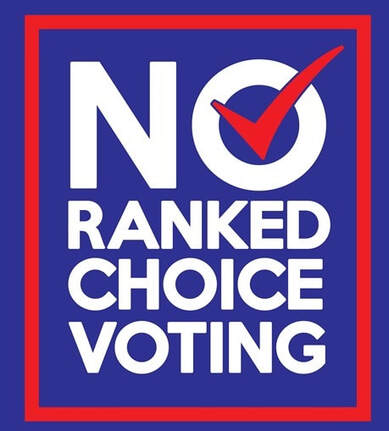|
The constitutionality of RCV turns on whether some voters are afforded “an increased opportunity to affect the outcome of an election” than other voters. Among similarly situated voters, the Equal Protection Clause does not permit some votes to carry a greater weight than others. At the heart of this inquiry is whether RCV’s rounds of tabulation function as one election or multiple elections. I believe RCV functions as multiple elections and in so doing inflicts four primary burdens on voting rights. 1. RCV Operates as Multiple Elections RCV operates as more than one election and in doing so, affords some voters a weightier and unequal opportunity to influence electoral outcomes. Strong evidence that RCV systems produce more than one election exists in the text of RCV statutes, interest groups that support RCV, and state officials who have defended RCV in court. Statutes that enact RCV direct election officials to engage in multiple “rounds” of vote disbursement. Moreover, election scholars confirm that RCV is more than one election. According to leading political science professor and voting systems expert, Dr. Jonathan D. Katz, an election is defined as a given set of voters choosing amongst a given set of candidates. Each time the voters and candidates change, there is a distinct and separate election. In practice, RCV does precisely that. If no candidate receives a majority of votes, the lowest candidates are removed from contention and eliminated from the pool of viable candidates. But not only do the candidates change in subsequent rounds of an RCV election, so do the voters. For example, in one San Francisco RCV election, by the final round of tabulation, twenty-seven percent of voters had their ranked ballots exhausted and were no longer actively participating with the other seventy-three percent of voters. Because both candidates and voters change in every subsequent round, RCV is properly considered not one, but multiple elections. Some may argue that RCV’s practical consequence of producing multiple elections is inconsequential. However, this commonly-deployed argument ignores the more serious threat lurking in the background. Although passed off as “subsequent rounds” of a single election, properly understood, RCV’s multiple elections treat some voters more favorably than others. Voters who rank a non-continuing candidate first, and thus have their second or third choice considered, get to morph their ballots into outcome determinative votes. In contrast, voters who rank a continuing candidate are stuck with a single choice and that single vote. Moreover, while some voters have their votes counted again and again, others have their ballots eliminated in RCV’s subsequent rounds. For an example, consider the election data from a San Francisco RCV election. It is illogical to suggest that the twenty-seven percent of voters who had their ballots exhausted by the last round were afforded an “equal chance” to impact the outcome of the election—they did not even have a vote to exercise in the later elections. Thus, contrary to the Ninth Circuit’s reasoning in Dudum, votes are not afforded the “same mathematical weight” in RCV elections. Rather, RCV operates as multiple, unequal elections where some votes are elevated to outcome-determinative status, some are locked in place, while others are exhausted entirely. 2. RCV Forces Voters to Participate in Hypothetical Elections
The legislative purpose and historical justifications for adopting RCV uncover another burden imposed on voting rights. RCV elections are often construed as efficient replacements of a two-election system. In a two-election system, the general election is held in November, and if one candidate does not receive a majority of the votes, a runoff election is held between the top two candidates. Before this runoff election, voters are able to reassess policy platforms, hear further debate, and ultimately cast a single vote for one of the two candidates. While RCV mimics this system, it severely distorts it. In practice, RCV operates as separate runoff elections conducted in secrecy behind closed doors. In these closed-door runoffs, no consideration is given to the fact that the pool of candidates and voters are ever-changing. Thus, RCV insists that a voter do what common sense says is impossible: predict the future and cast a vote in an uncertain, hypothetical election. Election experts and political scientists have long observed voting behavior as a product of numerous factors. While a voter’s party affiliation is most salient, the core bloc of undecided voters heavily consider a candidate’s approachability, family, religious affiliation, or upbringing. Because there are numerous candidates in an election, however, voters do not consider these factors in a vacuum but rather in relation to other candidates. Logically, in order to weigh a candidate’s platform, qualifications, and characteristics relative to other candidates, a voter must know the full array of candidates. When the candidates change, so do voter decisions. In practice, RCV precludes voters from deciding which candidates are worthy of their votes—a concept central to elections. To illustrate this point, consider if RCV had been used in the 2016 presidential election and the all-too common predicament of hypothetical Voter A. As to substantive political issues, Voter A was strongly in favor of Gary Johnson’s political platform, namely on maintaining a small national government and drug reform policy. While Voter A also agreed with the policies of Donald Trump, she found him to be too irreverent and unpresidential. Voter A disagreed with most of Hillary Clinton’s political positions, but her extensive career in government made her far more poised and professional than Trump. Voter A also found Clinton more approachable and trustworthy than Trump. In light of these considerations, Voter A ranked her ballot as follows: (1) Johnson (Libertarian); (2) Clinton (Democrat); (3) Trump (Republican). As was the reality in numerous 2016 battleground states, suppose that neither Clinton nor Trump reached the fifty-percent threshold and thus, as the lowest vote-getter, Johnson was eliminated in the first round of RCV. At this point, the RCV process seems facially harmless. Remember, however, that Voter A’s selections were based both on the relative weight of the candidates’ substantive political positions as well as temperament, approachability, and character traits. As studies of voter behavior suggests, it is possible—perhaps even likely—that, in a separate election between only Clinton and Trump, Voter A’s preference for Trump’s substantive policy positions would now outweigh her favor of Clinton’s personality. But the RCV ballot entirely fails to consider that reality. In practice, RCV forces voters to gaze into the crystal ball and forecast their preferences should the pool of candidates change, and in real time, cast votes based on hypothetical, future elections. This is the functional equivalent of requiring voters to select a party nominee in a spring primary election, while also casting their vote for the general election without knowing who the other candidates will be or hearing any further debate from those candidates. This feature of RCV not only burdens voting rights and leads to wasted ballots, it is fundamentally illogical. 3. RCV Defies Electoral Common Sense RCV elections also violate a commonsense notion of electoral behavior known as monotonicity. The principle is straightforward: ranking a candidate first should never cause that candidate to lose, and ranking a candidate lower than first should never cause that candidate to win. RCV, however, suffers from the problem of non-monotonicity—where a candidate can lose after receiving an increase in support. Likewise, a disfavored candidate can win by experiencing a decrease in support. Thus, RCV’s ranking structure can reward candidates who receive no increase in support during subsequent rounds and disadvantage candidates who garner more voter support. In forty percent of RCV elections where the plurality winner ultimately lost, non-monotonicity was the culprit. Thus, RCV’s non-monotonicity tempts voters to engage in electoral chicanery by ranking their favorite candidate second or third to avoid harming her in subsequent rounds of vote tabulation. Yet again, RCV produces a result devoid of logic. 4. RCV Generates Voter Confusion While exercising the right to vote should be a straightforward practice, RCV is unduly complex. RCV is not only confusing to understand initially but that confusion follows voters into the ballot box. In fact, RCV ballots increase the rate of voter error through a phenomenon called overvoting. An overvote occurs if a voter selects more than one candidate in a single round of an RCV election or votes for the same candidate more than once. Although this seems like a quick educational fix, many voters cast an overvote in earnest. For example, some voters believe that to express support for their favorite candidate in an RCV election, they need to fill in the box next to that candidate’s name for each round. When overvotes occur, the voter’s entire ballot is “exhausted” and rendered null and void for the entire election. In other words, a simple voter mistake leads to a disenfranchised voice. To be certain, the argument that RCV elections increase vote exhaustion is not a hypothesis; it actually happens. For example, during the initial round of an RCV election in San Francisco, 820 ballots were exhausted due to an overvote. Additionally, in Maine’s Second Congressional District election, 6,453 votes were exhausted in the first round alone. By the final round of tabulation, over 15,000 votes had been thrown out. Of these, 533 voters had overvoted and another 335 votes were not counted for failure to select a continuing candidate. In closely contested elections decided by a few thousand votes, these numbers are significant. The electoral confusion and disenfranchisement created by RCV also impacts voters disproportionately along lines of race, age, and gender. Following San Francisco’s implementation of RCV, election scholars conducted studies to better understand RCV’s impact on overvoting and general voter confusion. The results are cause for concern. After RCV was implemented, the rate of exhausted ballots and overvoting increased in minority precincts primarily comprised of African American, Latino, and foreign-born voters. Precincts with higher elderly and low-income populations saw similar increases. Further, studies find that women are more likely than men to have ballots exhausted because of RCV errors. Taken together, RCV imposes four primary burdens on voting rights and voter efficacy. First, RCV functions as numerous, closed-door runoff elections, where some voters are afforded a greater weight and ability to influence the outcome of an election. Second, RCV deprives voters of an educated and meaningful vote in those subsequent elections. Third, RCV defies the core tenets and common-sense nature of elections. Fourth, RCV is confusing, both in theory and in practice, such that an increased number of voters commit error resulting in disenfranchisement. The standard counterargument is that votes are simply counted the same at each round of the RCV election, but cloaked behind that simplistic justification lies the reality that, while numerically counted the same, these votes are fraught with voter confusion, uncertainty, and inequity. From Brandon Bryer, One Vote, Two Votes, Three Votes, Four: How Ranked Choice Voting Burdens Voting Rights and More, 90 U. Cin. L. Rev. (2021) Available at: scholarship.law.uc.edu/cgi/viewcontent.cgi?article=1432&context=uclr
0 Comments
Leave a Reply. |
AuthorBill Olson Archives
April 2024
Categories
All
|



 RSS Feed
RSS Feed
